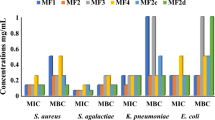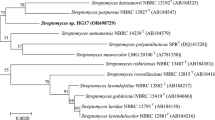Abstract
Increasing resistance to antibiotics is a major problem worldwide and stimulates the development of new bacterial inhibitors. Series of oxazolo[4,5-b]pyridine synthesized in our lab was examined to screen them as potential antimicrobial agents. The antimicrobial analyses of the synthesized compound were based on minimum inhibitory concentration determination, against four strains of bacteria. The results showed that the synthesized compounds have elicited good activity profile against methicillin-resistant Staphylococcus aureus (S. aureus), the bacterium that is largely responsible for hospital-acquired infections. Moreover, synthesized compounds were also docked against enterotoxin protein of S. aureus which belongs to Staphylococcal enterotoxin type A(SEA). In vitro and in silico studies revealed that compounds 3d, 3g, and 3h have demonstrated significant antibacterial activity in comparison to the standard control drug ampicillin and streptomycin.






Similar content being viewed by others
References
Argudin MA, Mendoza MC, Rodicio MR (2010) Food poisoning and staphylococcus aureus enterotoxins. Toxins 2:1751–1773
Arisoy M, Temiz-Arpaci O, Yildiz I, Kaynak-Onurdag F, Aki E, Yalçin I, Abbasoglu U (2008) Synthesis, antimicrobial activity and QSAR studies of 2,5-disubstituted benzoxazoles. SAR QSAR Environ Res 19:589–612
Bernardino AMR, De Azevedo AR, Pinheiro LCD, Borges JC, Carvalho VL, Miranda MD, De Meneses MDF, Nascimento M, Ferreira D, Rebello MA (2007) Synthesis and antiviral activity of new 4-(phenylamino)/4-[(methylpyridin-2-yl)amino]-1-phenyl-1H-pyrazolo[3,4-b]pyridine-4-carboxylic acid derivatives. Med Chem Res 16:352–369
Chu DTW, Plattner JJ, Katz L (1996) New directions in antibacterial research. J Med Chem 39:3853–3874
Clark RL, Pessolano AA, Witzel B, Lanza T, Shen TY, Van Arman CG, Risley EA (1978) 2- (Substituted phenyl) oxazolo[4,5-b] pyridines and 2-(substituted phentl) oxazolo[5,4-b] pyridines as non acidic anti-inflammatory agents. J Med Chem 21:1158–1162
Davies J (1996) Bacteria on the rampage. Nature 383:219–220
Duchowicz PR, Vitale MG, Castro EA, Fernandez M, Caballero J (2007) QSAR analysis for heterocyclic antifungals. Bioorg Med Chem 15:2680–2689
Ertan T, Yildiz I, Tekiner-Gulbas B, Bolelli K, Temiz- Arpaci O, Ozkan S, Kaynak F, Yalçin I, Aki E (2009) Synthesis, biological evaluation and 2D-QSAR analysis of benzoxazoles as antimicrobial agents. Eur J Med Chem 44:501–510
Khan AT, Choudhary LH, Ghosh S (2006) Silica supported perchloric acid (HClO4-SiO2): A highly efficient and reusable catalyst for geminal diacylation of aldehydes under solvent-free conditions. J Mol Cata A 255:230–235
Khizhan EI, Khizhan AI, Nikolaevskii AN, Kniga OP, Ivleva TN, Tikhonova GA (2011) Antioxidant activity of 2-methyl-1,3-benzoxazol-6-ol. Russ J Gen Chem 81:122–127
Mikko J, Ki M, Koskinen AMP (2007) A rapid method for the preparation of 2-substituted oxazolo[4,5-b]pyridines using microwave assisted direct condensation reactions. Tetrahedron Lett 48:2295–2298
Mohamed MS, Awad YED, Hallouty E, Salwa M, Araby ME (2012) Design, synthesis and cancer cell line activities of pyrazolo[3,4-b]pyridine derivatives. Open J Med Chem 2:78–88
Murthy YLN, Rajack A, Taraka Ramji M, Jeson babu J, Praveen Ch, Aruna Lakshmi K (2012) Design, solvent free synthesis and antimicrobial evaluation of 1,4 DHP. Bioorg Med Chem Lett 22:6016–6023
Ouyang L, Huang Y, Zhao Y, He G, Xie Y, Liu J, He J, Liu B, Wei Y (2012) Preparation, antibacterial evaluation and preliminary structure–activity relationship (SAR) study of benzothiazol- and benzoxazol-2-amine derivatives. Bioorg Med Chem Lett 22:3044–3049
Paronikyan EG, Noravyan AS, Dzhagatspany IA, Nazaryan IM, Paronikyan RG (2002) Synthesis and anticonvulsant activity of isothiazolo[5,4-b]pyrano(thiopyrano)[4,3-d]pyridine and isothiazolo[4,5-b]-2,7-naphthyridine derivatives. Pharm Chem J 36:465–467
Patel NB, Agravat SN, Shaikh FM (2010) Synthesis and antimicrobial activity of new pyridine derivatives-I. Med Chem Res 20:1033–1041
Pathak R, Kumar R, Gautam HK (2013) Cross-species induction and enhancement of antimicrobial properties in response to gamma irradiation in exiguobacterium species HKG 126. Indian J Microbiol 53:130–136
Pinchuk IV, Beswick EJ, Reyes VE (2010) Staphylococcal enetrotoxins. Toxins 2:2177–2197
Reen GK, Dudhe P, Ahuja M, Kumar A, Sharma P (2015) Acid-catalyzed, silica supported, one-pot benzoylation route to synthesize 2-(substituted phenyl) oxazolo[4,5-b] pyridines under ambient conditions. Synth Commun 45:1986–1994
Sharma P, Rane N, Gurram VK (2004) Synthesis and QSAR studies of pyrimido[4,5-d]pyrimidine-2,5-dione derivatives as potential antimicrobial agents. Bioorg Med Chem Lett 14:4185–4190
Sharma P, Kumar A, Upadhyay S, Sahu V, Singh J (2009) Synthesis and QSAR modeling of 2-acetyl-2-ethoxycarbonyl-1-[4(4’-arylazo)-phenyl]-N,N-dimethyl aminophenyl aziridines as potential antibacterial agents. Eur J Med Chem 44:251–259
Sharma P, Kumar A, Upadhyay S, Singh J, Sahu V (2010) A novel approach to the synthesis of 1,2,3-triazoles and their SAR studies. Med Chem Res 19:589–602
Sharma P, Kumar A, Kumari P, Singh J, Kaushik MP (2012) QSAR modeling of synthesized 3-(1,3-benzothiazol-2-yl)2-phenyl quinazolin-4(3H)-ones as potent antibacterial agents. Med Chem Res 21:1136–1148
Thomsen R, Christensen MH (2006) MolDock: A new technique for high accuracy molecular docking. J Med Chem 49:3315–21
Vondenhoff GHM, Aerschot AV (2011) Aminoacyl-tRNA synthetase inhibitors as potential antibiotics. Eur J Med Chem 46:5227–5236
Acknowledgements
This work is supported by the financial assistance received from UGC-SAP-DRS-I [No. F. 540/13/DRS-I/2016(SAP-I)] and G.K.R is thankful to UGC-MANF (F1-17.1/2017-18/MANF-2017-18-MAD-73866 /(SA-III/Website)) for Junior Research Fellowship. The authors are thankful to Sophisticated Analytical Instrumentation Facility Punjab University, Chandigarh, for providing experimental results.
Author information
Authors and Affiliations
Corresponding author
Ethics declarations
Conflict of interest
The authors declare that they have no competing interests.
Electronic supplementary material
Rights and permissions
About this article
Cite this article
Reen, G.K., Kumar, A. & Sharma, P. In vitro and in silico evaluation of 2-(substituted phenyl) oxazolo[4,5-b]pyridine derivatives as potential antibacterial agents. Med Chem Res 26, 3336–3344 (2017). https://doi.org/10.1007/s00044-017-2026-3
Received:
Accepted:
Published:
Issue Date:
DOI: https://doi.org/10.1007/s00044-017-2026-3




